Opus Insignium Armorumque 1687 - 1688 Das Grosse Wappenbuch
February 2005
One of the most important works produced by a herald is a roll of arms or armory depicting the coats of arms of notable individuals, organizations, nobility and sometimes, the armory would include civic arms. In Slovenia, such an armory exists in the form of a book entitled "Heraldic Insignia and Devices" or "Opus Insignium Armorumque" containing an archive of 2041 fabulous paintings of coats of arms covering the notable families in the regions of Slovenia and  | | Portrait captured from the ceiling of the Narodni muzej Slovenije - Slovenian National Museum - D.Cvet, Oct 2005 |
Janez Vajkard Valvasor (1641-1693)
The baron Janez Vajkard Valvasor, who became a member of the Royal Society in London in 1687, was a polymath or, more precisely, a historiographer, geographer, ethnographer, cartographer, naturalist and technician; moreover, he was a collector, sketcher and publisher as well as a soldier and military commander. Valvasor's ancestors originated from the province of Bergamo in northern Italy. They settled in the one-time crown land of Carniola, the central region of the present-day Republic of Slovenia, in the l6th century. Their family's country seat was the Medija castle near Zagorje. Janez Vajkard was born in 1641 in the region's capital Ljubljana, where he was baptized on May 28th of the same year and where he was educated at the Jesuitic grarnmar school.
From his very childhood he distinguished himself with his great eagerness for research, universal scientific interest and strong patriotism. When he realized during his journeys that his country was very little known abroad or was not known at all, he got into his head the idea of presenting Carniola to the world in words and pictures. Besides writing about Carniola, Valvasor also wrote descriptions of Carinthia and published instructional and literary works of art.
From 1679 to 1689 Valvasor wrote and published the following works: Dominicae passionis icones, Topographia Ducatus Carnioliae modernae, Topographia arcium Lambergianarum, Ovidii Metamorphoseos icones, Topographia Archiducatus Carinthiae modernae, Topographia Carinthiae Salisburgensis, Theatrum mortis humanae tripartitum, Topographia Archiducatus Carinthiae antiquae et modernae completa, Die Ehre des Hertzogthums Crain. He prepared in manuscript two more naturalistic treatises: Lumen naturae and Flos physicomathematicus, a work of art Satirical Ovid - these works have not been preserved to date. Author: Prof. Dr. Branko Reisp, 1993
The heraldic armory entitled Opus Insignium Armorumque, containing illustrations of more than 2,000 coats of arms is described in detail below.
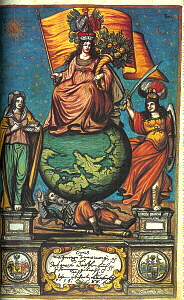 |  | 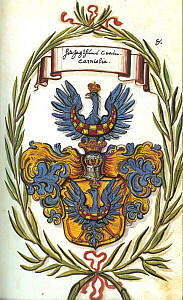 | | Introductory allegorical painting depicting the arms of Valvasor (dexter) and the family Zetschker (sinister) | Valvasor's coat of arms following the introductory painting in the manuscript. | Cover page for the chapter on arms from Carniola. |
Due to enormous cost of producing the armory, Valvasor had to sell much of his possessions including property in order to support the project. The possessions sold also included his extensive library which was purchased by the Archbishop of Zagreb, and which currently resides in the Zagreb Archives today. However, the armory is available for study because in 1993, a luxurious reprint was created in two volumes in a limited publication of only 999 copies, published by the Slovenian Academy of Sciences and Arts. However, there are no plans for a second reprint of his armory.
About "Opus Insignium Armorumque"
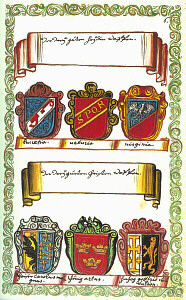 | | Fictitious arms, including those of King Arthur (bottom centre) |
- Fictitious coats of arms (leaves 4-7),
- Carniolan coats of arms (leaves 8-171),
- Styrian coats of arms (leaves 172-227),
- Carinthian coats of arms (leaves 228-259),
- German and other coats of arms (leaves 260-370),
- index of coats of arms (leaves 371-388).
The first chapter contains a number of fictitious coats of arms of fairy tale characters and rulers who existed during pre-heraldic times. Fictitious arms were considered the "norm" for heraldic publications of the period, and Valvasor, having been inspired by J. Siebmacher's work in 1657, included these arms in his armory. This section begins with a depiction of the arms of the "first world", followed by the coats of arms of notable persons such as Adam and Noah, depictions of arms of three good Jews: Joshua, David and Maccabee; three good Jewesses: Esther, Judith and Jaele; three good pagans: Hector, Alexander the Great and Julius Caesar; three good pagan women: Lucretia, Veturia and Virginia; three good Christians: Charles the Great, King Arthur and Duke Gotfried of Bouillon and other characters and personages.
The Carniolan arms constitutes approximately 44% of the book. This was because Valvasor's love of Carniola, and his desire to present to the world, the beautiful images representing Carniola, which to date, have been either poorly presented or not published at all. This chapter begins with the coat of arms of Carniola, followed immediately with the coat of arms of Slovenska Marka. This is followed with two provincial arms, and ten coats of arms of families who were the "titulars" of the hereditary estate rights in Carniola including the Auesperg family, the counts of Egkh, Princes of Eggenberg, the Hohenwarts, etc. Following this section in this chapter, are renderings of Ljubljana bishops, classified according to the period of their office, such as Žiga Lamberg (1463-1488), Krištof
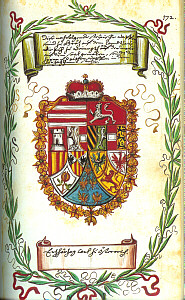
| 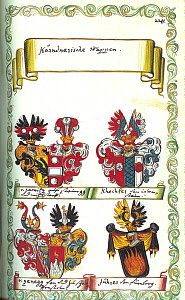
| 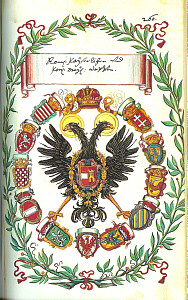 |
| Cover arms of the chapter on Styrian arms |
Cover arms of the chapter on Carinthian arms |
Cover arms of the chapter on German arms |
The third chapter covers the arms of families from the Styrian (Štajersko) region, many of whom also possessed lands in Carniola. This chapter constitutes approximately 15% of the book. The arms are divided into two groups: the first group containing arms taken from the coats of arms painted on the Town Hall of Graz, and the second group from the wall of Kravjek Hall.
The fourth chapter contains 187 coats of arms of Carinthian noble families, however, unlike the Carniolian arms, this chapter does not include the arms of the towns nor ecclesiastical arms. The cover page of this chapter does not reveal the source of the coats of arms. Interesting to note, that the leaves from 251 to 259 are rendered without helmets, mantling or crests. The arms are placed in carthouches topped with crowns. It is possible that Valvasor had sourced these images from a heraldry book depicted in such a manner and simply transposed them to this book.
The fifth chapter presents coats of arms sourced mostly from one of the most famous heralds, J. Siebmacher who first published an armory in 1596. The most well known publication is the "New Wapenbuch" published in 1605 containing 226 tables with 15 coats of arms on each engraving. The chapter cover page depicts the coat of arms of the German empire, surrounded by regional coats of arms including the Dalmatian coat of arms (three gold crowned lion heads on a blue field), the Bosnian coat of arms (bent red right arm holding a sword on a gold field), the Carniolian coat of arms, Styria and the Croatian coats of arms. The chapter also depicts arms of a number of German archdioceses and dioceses including those of Salzburg.
History of the armory
Valvasor's armory is bound in dark brown calf leather covering two beech-wood boards. The leaves are separately sewn by hand, as well as the two-tone headband above and below. The original publication featured two buckles which were later lost. The back and front leather-bound covers feature an embossed ornamental lines. A title tag was subsequently afixed between the first and second tailband, but was lost. The leaves of the book are gold-edged and the inner side of the front and back covers is lined with marble paper.
The depictions of the arms are painted on hand-made paper. The first three and the last five leaves are blank and not numbered. The book measures 31 cm in width and 20cm in height. The book is presently kept at the Metropolitan Library under the auspices of the Zagreb National and University Library, codex: Cod. Mr 160. The reprint of this book was created by the Slovenian Academy of Sciences and Arts in 1993 in which only 999 copies were published. The publication includes two volumes, the first containing the description and interpretation of the armory. The introduction written by Branko Reisp. The interpretation and description of the chapters by Božo Otorepec, and the piece on Bartolomej Ramschissl by Emilijan Cevc. Other contributors to this project include Janez Batis, Matjaž Kmecl, Peter Svetik and Ciril Zlobec. The editor of the publication was Ljoze Gostiša. The English translations by Alneka Goričan.
The second volume is the reprint of Valvasor's armory in its entirety. The reprint attempts to reproduce the original armory, with brown leather cover attached to a cloth covered board for the front and back covers. Some leather embossing is also visible. The reprint offers a detailed presentation of Slovenian heraldic history and is considered an invaluable resource in this area of study.
Sources
- Giacomo Scotti, Lambisce la nostra regione "La gloria della Carinzia", April 2002
- Slovenian Genealogy Society, Slovenian Heraldic Sampler - OPUS INSIGNIUM ARMORUMQUE
- Janez Vajkard Valvasor, "Opus Insignium Armorumque 1687 - 1688 Das Grosse Wappenbuch, re-published by the Slovenian Academy of Sciences and Arts, January 1993 (999 copies only), ISBN 86-7131-070-1.
- Pošta Slovenije d.o.o., 1993 Stamps, 300th anniversary of death of Janez Vajkard Valvasor, written by Prof. Dr. Branko Reisp / 300. obletnica smrti Janeza Vajkarda Valvasorja, avtor prof. dr. Branko Reisp
- Digital presentation of OPUS INSIGNIUM ARMORUMQUE
by David M. Cvet
February 2005
About the author: , born in Canada, son of Slovenian parents, is director of the Royal Heraldry Society of Canada (RHSC), president of the Toronto Branch of the RHSC, president and founder of the Academy of European Medieval Martial Arts in Toronto, and is also the founder of the Societas Heraldica Slovenica. During his study, research and reconstruction of medieval martial arts, he discovered heraldry had played a significant part in medieval history, and has expanded his research and study to include heraldry of Slovenia.
Slovenija Branch Copyright © 2005 All Rights Reserved
|